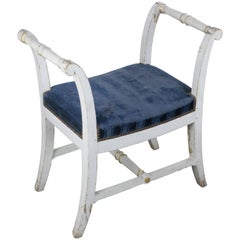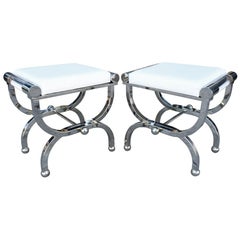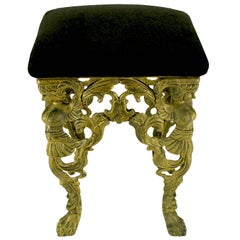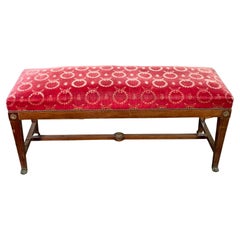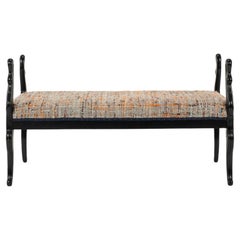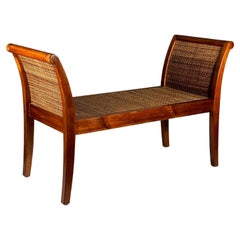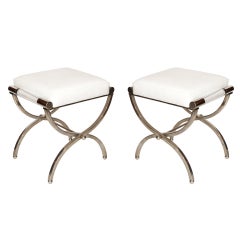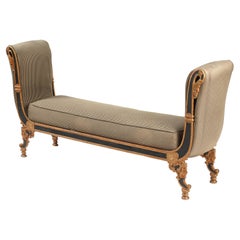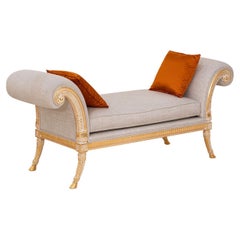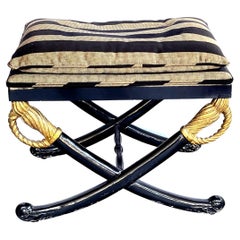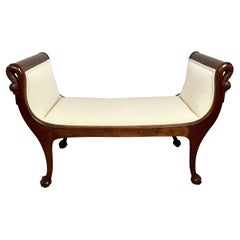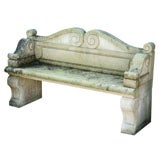Empire Style Bench
Early 20th Century French Directoire Benches
Beech
21st Century and Contemporary American Mid-Century Modern Benches
Nickel
21st Century and Contemporary American Mid-Century Modern Benches
Brass
Vintage 1920s American Stools
Iron
21st Century and Contemporary American Mid-Century Modern Benches
Nickel
Antique Early 19th Century French Empire Benches
Velvet, Hardwood
20th Century Empire Benches
Upholstery, Wood
Vintage 1970s North American American Empire Benches
Walnut
Vintage 1970s American Mid-Century Modern Benches
Steel, Nickel
Antique Late 19th Century French Empire Benches
Iron
2010s Italian Benches
Wood
Vintage 1960s American Empire Benches
Fabric, Wood
Early 20th Century American Empire Benches
Mahogany
Early 20th Century French Empire Benches
Gesso, Upholstery, Wood
Antique Early 19th Century Danish Empire Benches
Fabric, Mahogany
Antique 19th Century Benches
Wood
Antique Mid-19th Century French Empire Benches
Upholstery, Wood, Walnut
Antique Early 19th Century Danish Empire Benches
Fabric, Mahogany
1990s Empire Benches
Gold Leaf
Mid-20th Century Italian Empire Stools
Upholstery, Wood
Early 20th Century Unknown Neoclassical Benches
Fabric, Wood
Antique 19th Century French Empire Benches
Upholstery, Wood
Late 20th Century Unknown Other Benches
Brass
Mid-20th Century Italian Art Deco Benches
Brass
Vintage 1980s English Empire Daybeds
Upholstery, Wood
Antique Late 19th Century French Empire Stools
Mahogany
20th Century American Empire Ottomans and Poufs
Upholstery, Walnut
Recent Sales
Antique Late 19th Century French Empire Benches
Walnut
20th Century French Patio and Garden Furniture
21st Century and Contemporary Italian Empire Benches
Wood
Mid-20th Century Italian Empire Revival Benches
Brass, Iron
2010s Italian Empire Benches
Gold Leaf, Silver Leaf
Early 20th Century Unknown Empire Benches
Leather, Linen, Upholstery, Natural Fiber, Giltwood
Antique Late 19th Century French Empire Benches
Ormolu
Antique 19th Century French Footstools
20th Century Italian Benches
Wood, Cane
Early 20th Century French Benches
Wood
20th Century Benches
Metal
Early 20th Century American Benches
Iron
20th Century American Benches
Wood
Antique 19th Century French Empire Benches
Velvet, Giltwood
Early 20th Century French Footstools
Wood
Vintage 1930s Italian Empire Ottomans and Poufs
Fabric, Upholstery
20th Century Empire Benches
Mahogany
Vintage 1950s French Empire Benches
Vintage 1960s Empire Benches
Fabric
Antique 19th Century Empire Benches
Wool, Mahogany
Early 20th Century Swedish Belle Époque Benches
Upholstery, Giltwood
20th Century Empire Benches
Upholstery, Wood
Early 20th Century French Empire Benches
Mahogany
Vintage 1960s Empire Benches
Faux Leather, Paint, Wood
Mid-20th Century Italian Empire Benches
Steel
Antique 19th Century French Benches
Upholstery, Wood
20th Century French Benches
Vintage 1960s American Empire Footstools
Upholstery, Wood
2010s French Empire Benches
Iron
Antique 1890s French Empire Revival Benches
Mahogany
Early 20th Century French Empire Benches
Early 20th Century English Empire Benches
Linen, Upholstery, Wood
Antique 1890s French Empire Benches
Walnut
Mid-20th Century American Empire Benches
Velvet, Mahogany
Vintage 1970s Empire Benches
Brass, Iron
Late 20th Century Philippine Empire Benches
Upholstery, Mahogany, Giltwood
Vintage 1970s American Benches
Brass
Mid-20th Century French Mid-Century Modern Daybeds
Upholstery, Wood
20th Century French Benches
Walnut, Upholstery
20th Century European Regency Benches
Hardwood
20th Century American Neoclassical Benches
Upholstery, Wood, Mahogany
Antique 19th Century Benches
Upholstery
20th Century Empire Benches
Mahogany, Upholstery
Antique Early 1900s French Empire Revival Benches
20th Century Empire Benches
Upholstery, Mahogany
Vintage 1970s Benches
Aluminum
Early 20th Century Empire Benches
Upholstery, Hardwood
Antique 19th Century French Empire Benches
Fabric, Wood, Walnut, Upholstery
Antique Mid-19th Century Italian Benches
Upholstery, Wood
Antique Mid-19th Century American Benches
Damask, Mahogany
Vintage 1960s Neoclassical Benches
Brass, Bronze, Iron
Antique Early 19th Century French Empire Benches
21st Century and Contemporary American Empire Benches
Brass
20th Century Empire Benches
Fabric, Wood
Antique Mid-19th Century Swedish Empire Settees
Muslin, Linen, Wood
20th Century Empire Revival Stools
Mohair, Giltwood
Antique 18th Century and Earlier Unknown Empire Footstools
Wood, Upholstery, Paint
People Also Browsed
21st Century and Contemporary European Neoclassical Benches
Iron
2010s Italian Renaissance Wall Mirrors
Glass
21st Century and Contemporary American Modern Bookcases
Brass, Stainless Steel, Metal
21st Century and Contemporary Italian Modern Armchairs
Upholstery
Late 20th Century French Modern Decorative Boxes
Silver Plate
Late 20th Century Italian Chinese Chippendale Wall Mirrors
Mirror, Wood
2010s Italian Modern Wall Lights and Sconces
Murano Glass
21st Century and Contemporary American Bohemian Chandeliers and Pendants
Brass
21st Century and Contemporary Swedish Mid-Century Modern Table Lamps
Textile
Antique Late 19th Century British Edwardian Bookcases
Softwood
Antique 1890s French Renaissance Planters, Cachepots and Jardinières
Wood
Vintage 1960s Benches
Wood
Late 20th Century Brazilian Armchairs
Wood
Antique 1820s Scottish Georgian Fireplace Tools and Chimney Pots
Steel
2010s British Mid-Century Modern Wall Mirrors
Brass, Bronze
Late 20th Century American Modern Swivel Chairs
Bouclé
Empire Style Bench For Sale on 1stDibs
How Much is a Empire Style Bench?
Finding the Right Benches for You
Don’t underestimate a good bench — antique and vintage benches are storage pieces, stylish accents and statement-making additional seating.
Today, benches are a great option to maximize seating in your house and outdoor space. The perfect option to create a warm, welcoming atmosphere in foyers and entryways, benches can also transform dining areas, making it possible to host a hungry family with limited space. Whether you’re sprucing up your entertaining with upholstered Empire-style benches or adding more options to a dining room that’s seen a farmhouse makeover, this humble furnishing has only become more versatile over the years. Designers have recognized the demand for a good bench, crafting the convenient seating alternative from a range of materials, including wood, iron and even concrete.
Mid-century modern benches from George Nakashima, Charlotte Perriand and the pared-down Platform bench by George Nelson for Herman Miller are classics of innovation, but maybe you’re looking for an unconventional design approach to your home's seating. Opt for something totally outside the box — an antique pine church-pew bench paired with a vintage wool throw and stationed under the mounted coatrack in your mudroom is a distinctive touch.
For your outdoor oasis, a wrought-iron patio bench is the obvious choice but not the only option. An enclosed back patio would do well to inherit a rattan bench with cushions, but it can be susceptible to weathering and should be covered or moved indoors when not in use.
Whatever your seating arrangement needs are, find vintage, new and antique benches for every space on 1stDibs.
- 1stDibs ExpertApril 5, 2022The Classical world is primarily what influenced French Empire furniture. Greek and Roman motifs appear on many pieces. In addition, the opulence of Egyptian furniture inspired furniture makers active during the period. On 1stDibs, shop a range of French Empire furniture.
- 1stDibs ExpertOctober 7, 2024The difference between the Biedermeier and Empire styles lies largely in the characteristics most commonly associated with them. Although these two furniture styles both emerged around 1815 and persisted into the 1840s, pieces associated with them have differing features. Developed in France, the Empire style emphasized ornamentation and grandeur, with furniture makers often drawing inspiration from ancient Roman forms. Dark woods were the most commonly used materials of the style. In Germany and other parts of Central Europe, artisans working in the Biedermeier style favored simplicity. They also tended to source woods locally and chose light finishes for their pieces. Explore a selection of Biedermeier and Empire furniture on 1stDibs.
Read More
All the Furniture in This Organic Modern Soho Loft Can Be Yours
Andrianna Shamaris has filled her epic new home with pieces of her own design.
20 Inviting Dining Rooms Perfectly Arranged for Entertaining
Top interior designers show — and tell — us how to create delectable spaces for hosting dinner parties.
Nobody Puts This Sunny Sofa in a Corner
With its plush cushions, cane details and dazzlingly colorful back, it’s inviting from every angle.
The 21 Most Popular Mid-Century Modern Chairs
You know the designs, now get the stories about how they came to be.
Fred Rigby’s Modular Seating Can Be Configured in So Many Handy Ways
The plush Cove Slipper 2.5 Seater sofa is just one of many convenient combinations from the London-based maker.
This Chubby-Chic Quilted Stool Stands on Its Own Two Feet
Sam Klemick's cool stool is edgy, cozy and environmentally sustainable all at once.
Is Lionel Jadot the Willy Wonka of Upcycled Belgian Design?
From his massive collaborative workshop in a former paper factory, the designer concocts funky furniture from disused materials, as well as luxe hotel interiors like the new Mix Brussels.
Rock Your Cares Away on This Sunny Hand-Crocheted Swing
The boho-chic Enchanted Forest Swing, handmade by marginalized women from Turkey and Syria, is uplifting in every way.
